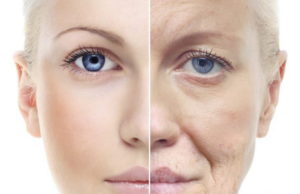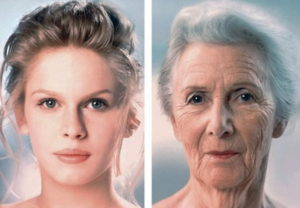
Sudden Aging at 44 and 60: What Changes and How to Prevent It
This extremely important study, published in Nature, was covered by many science bloggers. But I’m sure many of you may have missed this discovery, so I’m highlighting it again. Now read every word very carefully.
Scientists have discovered: we don’t age gradually — we age in leaps!
There are two key “drop-off” ages — at 44 and 60. That’s when the body changes rapidly at the molecular level.
What are molecular variables?
They are the internal “world” of our body.
The transcriptome shows how genes “switch on” and control the body. We carry the same genes throughout life, but they don’t function the same way at all times. The transcriptome is the set of active instructions — the genes being “read” at a given moment. Different sets of genes are read and executed at different stages of life.
At key aging leaps — 44 and 60 years — the set of active genes changes sharply. Genes linked to inflammation, cellular aging, and reduced regeneration become more active. At the same time, genes responsible for cellular repair become less active.
As a result: the body’s ability to repair itself declines, and a background of “silent” inflammation increases — accelerating aging.
The proteome refers to which proteins are produced — and proteins are the “building blocks” of our body.
The body’s protein composition changes: there is a decline in proteins responsible for growth, tissue repair, and hormonal balance.
Meanwhile, levels of “bad” proteins rise — those that promote inflammation, fibrosis, and oxidation. The balance of enzymes supporting the heart, blood vessels, and brain is disrupted.
Result: muscles weaken, blood vessels lose elasticity, and brain function slows down.
The metabolome includes all the small molecules produced during metabolism — glucose, fats, amino acids. They provide energy, build cells, and sustain life.
In other words, the metabolome reflects how metabolism functions. During aging “drop-offs,” the cells' ability to process energy changes: insulin resistance develops (impaired sugar processing). Fat starts to accumulate differently — around organs and in the liver. Lipid balance is disrupted — with more “bad” cholesterol.
Result: increased risk of diabetes, obesity, liver issues, and heart problems.
The microbiome is a collection of bacteria, fungi, and other microorganisms in our body (mostly in the gut). They help digest food, produce vitamins, and support immunity, mood, and brain function.
During aging “drop-offs,” bacterial diversity decreases — this is a marker of aging. The number of pro-inflammatory bacteria that release toxins increases. Meanwhile, the amount of bacteria that produce short-chain fatty acids declines — these acids protect against inflammation and gut diseases.
Result: immunity weakens, digestive issues arise, and systemic inflammation increases.
Why it matters?
These changes don’t happen gradually — they occur suddenly, and after that, the body functions on a “new, less efficient level.”
That’s why for many people at age 44 or 60, there’s a sudden:
- onset of fatigue;
- fat gain;
- heart pain;
- drop in endurance;
- memory decline.
The study showed: only 6% of these variables (metabolome, proteome, microbiome, etc.) change gradually with age. But 81% — change ABRUPTLY, in specific periods of life.
That’s why we often feel: “Everything was fine — and then suddenly my health got worse.” It’s not your imagination — it’s a biological fact.
What exactly changes?
Jump #1 — around age 44:
- Liver, fat metabolism, alcohol processing — all become less efficient.
- Heart and blood vessels — circulation is no longer as effective.
- Skin and muscles — start losing firmness and strength.
Jump #2 — around age 60:
- Immunity weakens.
- Sugar metabolism is impaired — diabetes risk increases.
- Kidney function declines — filtration becomes less effective.
- Plus, further decline in heart, skin, and muscle condition.
That’s why at 44 and 60, many people feel that “aging suddenly hits” — even though everything seemed fine just the day before.
What to do? How to smooth out these jumps?
Prepare IN ADVANCE — action should start before age 40.
Smart monitoring:
- From age 35: do annual extended blood tests — glucose, lipids, liver and kidney function.
- Check vessels and heart: ECG, ultrasound.
- Microbiome analysis.
Balanced nutrition:
- Before age 44: minimal alcohol, less saturated fats, more fish, olive oil, vegetables, berries.
- After age 60: more fiber (vegetables, whole grains), less sugar and simple carbs. More precisely: maximize fiber — vegetables, berries, greens — they feed the “good” microbiome bacteria. Omega-3: fatty fish or supplements. Low sugar and simple carbs — to prevent insulin resistance. Prebiotics and probiotics — to support the microbiome.
Movement and training:
- Strength exercises — support muscles and bones, slow aging, and stimulate the production of “youthful” proteins. Even 2–3 times a week is great.
- Aerobic activity — walking, running, swimming — for heart, blood vessels, and lungs.
- Flexibility and balance — yoga, stretching — to stay mobile.
Sleep and recovery:
- 7–8 hours of quality sleep each night. Quality sleep restores the transcriptome and proteome — nighttime activates repair genes.
- Maintain a healthy daily routine — avoid late-night exhaustion.
- Minimize stress. At least try breathing exercises or meditation — they reduce inflammation triggered by chronic stress.
Vitamins and minerals:
- Vitamin D, omega‑3, magnesium — only as prescribed by your doctor.
- After age 60 — preventive vaccinations, immune system support.
Personalization:
- Don’t follow trends blindly — choose the right nutrients, exercises, and tests with a qualified specialist.
In short:
Prepare FOR the jumps — and they won’t become collapses, dear ladies and gentlemen.
Take care of yourself now — and your body will reward you with energy and health even after 60.
Oksana SKYTALINSKA – medical doctor, dietitian
Based on materials from Facebook










